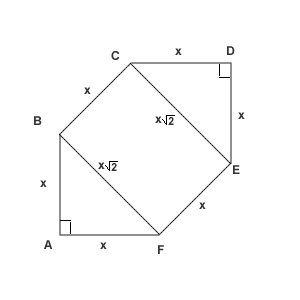Difference between revisions of "2006 AIME II Problems/Problem 1"
(→Solution 2) |
m (→Solution 2) |
||
| Line 49: | Line 49: | ||
label("{\tiny $A$}",A,S); | label("{\tiny $A$}",A,S); | ||
label("{\tiny $B$}",B,S); | label("{\tiny $B$}",B,S); | ||
| − | label("{\tiny $C$}",C, | + | label("{\tiny $C$}",C,dir(0)); |
label("{\tiny $D$}",D,N); | label("{\tiny $D$}",D,N); | ||
label("{\tiny $E$}",E,N); | label("{\tiny $E$}",E,N); | ||
label("{\tiny $F$}",F,W); | label("{\tiny $F$}",F,W); | ||
</asy> | </asy> | ||
| + | |||
| + | |||
| + | ~minor asymptote edit by Yiyj1 | ||
== See also == | == See also == | ||
Revision as of 02:19, 12 January 2024
Contents
Problem
In convex hexagon ![]() , all six sides are congruent,
, all six sides are congruent, ![]() and
and ![]() are right angles, and
are right angles, and ![]() and
and ![]() are congruent. The area of the hexagonal region is
are congruent. The area of the hexagonal region is ![]() Find
Find ![]() .
.
Solution
Let the side length be called ![]() , so
, so ![]() .
.
The diagonal ![]() . Then the areas of the triangles AFB and CDE in total are
. Then the areas of the triangles AFB and CDE in total are ![]() ,
and the area of the rectangle BCEF equals
,
and the area of the rectangle BCEF equals ![]()
Then we have to solve the equation
![]() .
.
![]()
![]()
Therefore, ![]() is
is ![]() .
.
Solution 2
Because ![]() ,
, ![]() ,
, ![]() , and
, and ![]() are congruent, the degree-measure of each of them is
are congruent, the degree-measure of each of them is ![]() . Lines
. Lines ![]() and
and ![]() divide the hexagonal region into two right triangles and a rectangle. Let
divide the hexagonal region into two right triangles and a rectangle. Let ![]() . Then
. Then ![]() . Thus
. Thus
![\begin{align*} 2116(\sqrt2+1)&=[ABCDEF]\\ &=2\cdot {1\over2}x^2+x\cdot x\sqrt2=x^2(1+\sqrt2), \end{align*}](http://latex.artofproblemsolving.com/7/b/4/7b4eac99a9d419ae9b76ff89eae925b572923827.png) so
so ![]() , and
, and ![]() .
.
![[asy] pair A,B,C,D,E,F; A=(0,0); B=(7,0); C=(13,6); E=(6,13); D=(13,13); F=(0,7); dot(A); dot(B); dot(C); dot(D); dot(E); dot(F); draw(A--B--C--D--E--F--cycle,linewidth(0.7)); label("{\tiny $A$}",A,S); label("{\tiny $B$}",B,S); label("{\tiny $C$}",C,dir(0)); label("{\tiny $D$}",D,N); label("{\tiny $E$}",E,N); label("{\tiny $F$}",F,W); [/asy]](http://latex.artofproblemsolving.com/9/1/a/91aceb75842732accdf7ebdb228cdc455ed91656.png)
~minor asymptote edit by Yiyj1
See also
| 2006 AIME II (Problems • Answer Key • Resources) | ||
| Preceded by First Question |
Followed by Problem 2 | |
| 1 • 2 • 3 • 4 • 5 • 6 • 7 • 8 • 9 • 10 • 11 • 12 • 13 • 14 • 15 | ||
| All AIME Problems and Solutions | ||
The problems on this page are copyrighted by the Mathematical Association of America's American Mathematics Competitions. 










